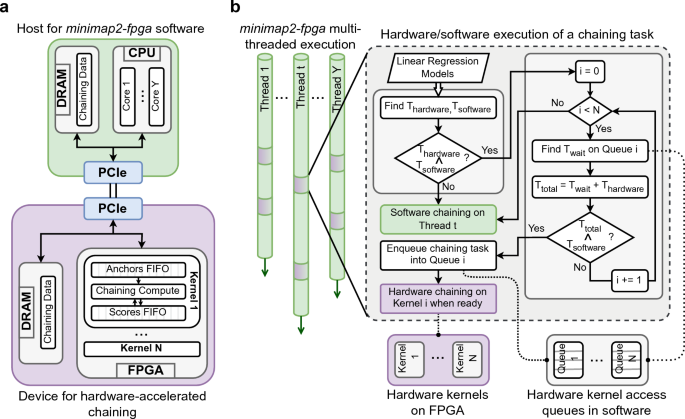Minimap2 is a widely used sequence alignment tool designed for efficiently mapping DNA or RNA reads against reference genomes. It supports a broad range of applications, including long-read alignment, splice-aware alignment for RNA sequencing, and whole-genome comparisons. Due to its high speed and accuracy, it has become a go-to aligner in genomics and bioinformatics pipelines. With the growing size of sequencing datasets, users often seek ways to improve performance, including leveraging modern multi-core processors through multi-threading.
Multi-threading is a method that allows software to utilize multiple CPU cores simultaneously, accelerating processing by dividing tasks across threads. This is particularly valuable for computational tools like minimap2 that handle large volumes of sequence data. Users frequently ask whether minimap2 supports multi-threading to reduce alignment time. This document explores that question in detail, clarifying minimap2’s threading capabilities, how to enable them, and what parts of the program benefit from parallel execution to improve overall performance in data-intensive workflows.
Understanding Multi-threading in Modern Computing
The Basics of Multi-threading Technology
Multi-threading is a powerful computing technique that enables a program to perform multiple operations at the same time. Instead of executing one task after another in sequence, multi-threading divides the workload into smaller threads that can be processed concurrently. This approach takes advantage of modern CPUs, which often have multiple cores capable of running these threads in parallel. As a result, the system becomes more efficient, and tasks can be completed faster compared to single-threaded execution.
How Multi-threading Enhances Performance
In applications that require heavy computation, such as processing large genomic datasets or aligning DNA sequences, multi-threading significantly boosts performance. When a multi-threaded program runs, each thread can handle a portion of the data, reducing the total time needed for analysis. This efficient distribution of work minimizes delays and maximizes the use of available hardware. For bioinformatics tools like minimap2, this means faster alignment of reads and quicker insights from high-throughput sequencing data, making multi-threading an essential feature in modern data processing.
Understanding Multi-threading in Minimap2
What Multi-threading Means in Bioinformatics Tools
Multi-threading is a powerful computing technique that allows applications like Minimap2 to run multiple processes at the same time. In the context of sequence alignment, this means distributing computational tasks across several CPU cores, resulting in significantly faster performance. Minimap2, a high-performance sequence alignment tool, is designed to efficiently handle large genomic datasets, and its multi-threading support makes it especially valuable for accelerating alignment tasks in both research and clinical genomics environments.
How to Use Multi-threading in Minimap2
Using the -t Option to Set Thread Count
Minimap2 enables multi-threading through a straightforward command-line option. The -t parameter allows users to specify how many CPU threads should be used during execution. For example, using minimap2 -t 8 instructs the software to operate with eight threads simultaneously. This flexibility lets users match thread usage to their system’s capabilities, whether they’re working on a personal workstation or a high-performance computing cluster. Efficient thread allocation can lead to faster alignment times and optimized resource usage.
Which Parts of Minimap2 Are Multi-threaded
Threaded Mapping and Alignment for Speed
In Minimap2, the core operations responsible for sequence mapping and alignment are fully multi-threaded. This includes processes that compare reads to the reference genome and compute alignments, which are often the most time-consuming tasks. These stages benefit greatly from parallel processing, resulting in faster output generation and improved throughput for large datasets. Users running high-volume sequencing projects will particularly notice performance gains when these multi-threaded steps are executed on multi-core systems.
Limitations in Threading for Index Loading
Single-threaded Behavior During Index Handling
While the mapping and alignment processes are optimized for multi-threading, it is important to note that index loading in Minimap2 does not utilize multiple threads. This means that when a reference genome index is being loaded into memory, only one CPU core is used. Although this phase is typically shorter in duration compared to mapping and alignment, it can become a noticeable bottleneck with very large reference files. However, once indexing is complete, multi-threading resumes for the subsequent steps, maximizing overall processing efficiency.
Performance and Scalability of Minimap2 Multi-threading
How Thread Count Impacts Minimap2 Performance
Minimap2 delivers substantial performance improvements when multiple threads are used, especially during alignment of large genomic datasets. By utilizing the -t option, users can allocate multiple CPU cores to the mapping process. This parallelization significantly reduces execution time in the mapping and alignment stages. The tool is designed to scale efficiently across threads, with noticeable gains when moving from single-threaded to 4, 8, or even 16-thread configurations, making it well-suited for high-throughput sequencing workflows.
Understanding Diminishing Returns in Thread Scaling
As the number of threads increases, the speed improvements begin to plateau due to hardware limitations such as disk input/output bandwidth and memory throughput. Minimap2’s core alignment processes are parallelized, but tasks like reference index loading remain single-threaded, creating bottlenecks at higher thread counts. For instance, moving from 16 to 32 threads may not yield double the performance, especially if storage is not SSD-based or if CPU threads compete for shared cache and memory bandwidth.
Benchmark Evidence Supporting Threading Efficiency
Benchmark tests from the original minimap2 documentation and independent bioinformatics evaluations demonstrate consistent improvements up to 8 or 16 threads, depending on the dataset size and hardware. On typical modern systems, users have reported 3–5× faster performance when using 8 threads compared to single-threaded runs on long-read data. These benchmarks validate that multi-threading in minimap2 offers real-world speedups that significantly benefit researchers handling large-scale sequencing projects with tight turnaround times.
Best Practices for Using Multi-threading in Minimap2
Understanding CPU Thread Allocation for Optimal Performance
When using minimap2, selecting the right number of threads is essential for achieving the best alignment performance. It is recommended to align the number of threads with the number of available CPU cores on your system. This ensures that each thread has dedicated computing power, reducing context-switching delays and maintaining consistent performance. For example, if a machine has 16 cores, setting -t 16 allows minimap2 to utilize the full processing capacity efficiently, enhancing throughput without resource conflicts.
Managing Shared Environments to Prevent Oversubscription
In shared computing environments, such as high-performance clusters or cloud-based systems, multiple users may run resource-intensive jobs simultaneously. Running minimap2 with more threads than the system can handle can lead to oversubscription, where too many processes compete for limited CPU resources. This causes slowdowns, inefficiency, and potential job failures. To avoid this, users should be aware of resource policies on the system and configure thread counts to align with assigned resources, ensuring both stability and fairness in multi-user environments.
Balancing Memory Usage and Thread Performance in Minimap2
While adding threads improves processing speed, it also increases memory usage per thread. Each thread in minimap2 may consume additional RAM for alignment operations and temporary data storage. On systems with limited memory, this can cause bottlenecks or even crashes if the total memory requirement exceeds what is available. Monitoring memory usage and adjusting the number of threads accordingly ensures that the system remains stable and efficient. This balance is especially important when handling large reference genomes or high-coverage sequencing data.
Conclusion
Minimap2 fully supports multi-threading, allowing users to significantly accelerate sequence alignment tasks by utilizing multiple CPU cores. By specifying the number of threads with the -t option, users can enhance performance, particularly when working with large genomic datasets. This feature makes minimap2 a practical and scalable tool for modern bioinformatics workflows. Multi-threading not only reduces runtime but also improves overall throughput, which is crucial for high-throughput sequencing projects and time-sensitive data analysis.
Effectively leveraging multi-threading in minimap2 requires understanding system resources and workload demands. Matching thread count to available CPU cores, avoiding oversubscription, and managing memory usage are key strategies for optimal performance. These practices ensure efficient, stable execution and help maximize hardware capabilities. With proper configuration, minimap2 can deliver high-speed, accurate alignments, making it a powerful solution for researchers and computational biologists handling complex sequencing data in both standalone and large-scale pipeline environments.

